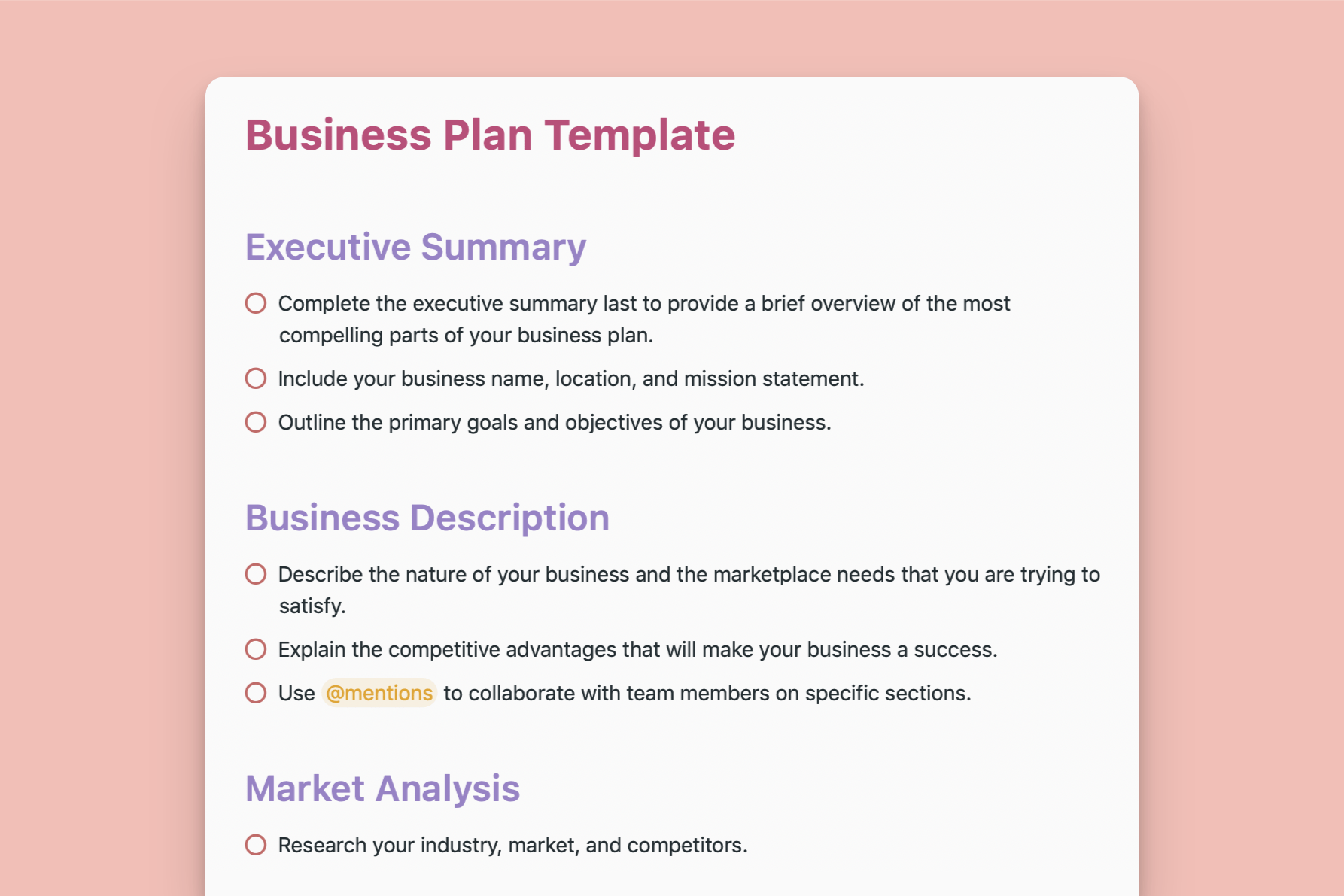Home

Business Plan
A comprehensive template to guide your business planning, from concept to execution.
Get things done with NotePlan
Categories
This detailed template provides a structured framework to articulate your business vision, strategy, and financial projections. It is designed to guide entrepreneurs, startups, and established businesses in crafting a compelling and comprehensive business plan. Use it to secure funding, attract investors, guide decision-making, or simply as a roadmap for your business's future.
Executive Summary
Craft this section last. It should encapsulate the most compelling aspects of your business plan.
- Business Overview: Succinctly introduce your business, including its name, location, and mission statement. What problem are you solving, and what value do you bring to the market?
- Goals and Objectives: Highlight the primary goals and objectives your business aims to achieve. Are you focusing on growth, market penetration, profitability, or innovation?
- Key Highlights: Summarize the unique strengths, competitive advantages, and financial projections that demonstrate your business's potential for success.
Business Description
- Nature of Business: Describe the core activities of your business. What products or services do you offer? What customer needs are you fulfilling?
- Marketplace Needs: Elaborate on the specific pain points or problems your business addresses within the market. How does your offering create value for your customers?
- Competitive Advantage: Clearly articulate what sets your business apart from competitors. Are your advantages based on technology, pricing, customer service, or other factors?
- @Collaboration: Use @mentions to collaborate with team members, ensuring everyone's insights are captured and all sections are thoroughly vetted.
Market Analysis
- Industry Overview: Provide a comprehensive analysis of your industry, including its size, growth trends, and key players.
- Target Market: Identify your ideal customer segments. Describe their demographics, psychographics, buying behaviors, and preferences in detail.
- Competitive Landscape: Analyze your competitors' strengths, weaknesses, opportunities, and threats (SWOT analysis). How will you position yourself to gain market share?
- Customer Segments Table: Write down different customer segments you are targeting here.
Organization and Management
- Structure: Illustrate your company's organizational chart, outlining roles, responsibilities, and reporting lines.
- Ownership: Detail the ownership structure of your business. Is it a sole proprietorship, partnership, LLC, or corporation?
- Team: Introduce your management team, highlighting their experience, skills, and track record. Are they the right people to lead your business to success?
- Board of Directors: If applicable, list your board members and their qualifications. What expertise do they bring to the table?
- Tasks: Utilize task management features to assign sections to team members, track progress, and ensure timely completion.
Products or Services
- Description: Provide a detailed overview of your products or services. Emphasize their features, benefits, and how they address customer needs.
- Value Proposition: Clearly state what makes your offerings unique and valuable to customers. How do they solve problems or enhance their lives?
- Product Lifecycle: Discuss the stages of your product lifecycle (development, introduction, growth, maturity, decline). How will you manage and adapt your offerings over time?
- Intellectual Property: If applicable, detail any patents, trademarks, or copyrights you hold. Do you have a plan to protect your intellectual property?
- Research & Development: If relevant, outline your R&D activities. Are you investing in new product development or continuous improvement?
Marketing and Sales Strategy
- Target Market Reach: Describe how you will effectively reach and engage your target customers. What channels will you use (online, offline, direct sales, partnerships)?
- Pricing Strategy: Explain your pricing model. Will you use premium pricing, value-based pricing, or competitive pricing?
- Promotion: Outline your promotional tactics. Will you use advertising, content marketing, social media, events, or public relations?
- Sales Process: Detail your sales approach. How will you generate leads, qualify prospects, and close deals?
Funding Request
- Amount: Clearly state the amount of funding you are seeking.
- Time Period: Specify the time frame the funding will cover (e.g., 12 months, 24 months).
- Use of Funds: Provide a detailed breakdown of how you intend to use the funds. Will they be used for hiring, marketing, inventory, equipment, or other expenses?
Financial Projections
- Projections: Present detailed financial projections to support your funding request and demonstrate the viability of your business model.
- Income Statement: Project your revenues and expenses over the next 3-5 years.
- Balance Sheet: Show your assets, liabilities, and equity at different points in time.
- Cash Flow Statement: Illustrate how cash will flow into and out of your business.
- Capital Expenditure Budget: If applicable, outline your planned investments in fixed assets (e.g., equipment, property).
- Financial Overview Table: Summarize your financial projections here.
Appendix
- Supporting Documents: Include any additional materials that strengthen your business plan. This could include: Credit histories Resumes of key team members Product photos or prototypes Letters of intent or contracts Market research data Legal documents (e.g., articles of incorporation)
Note: Business plans are not static documents. Review and update your plan regularly to ensure it reflects your current goals, market conditions, and financial performance.